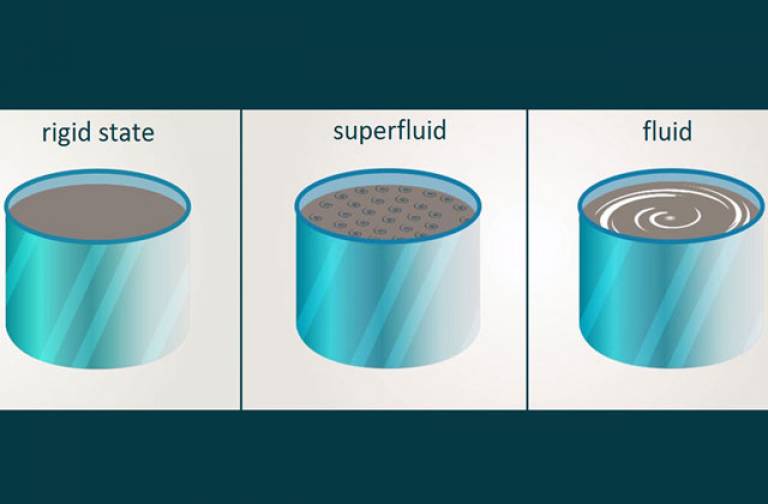The question of superfluidity in coherently driven microcavity-polaritons
3 October 2018
Researchers at UCL and St. Andrews have suggested that coherently pumped polaritons flowing without viscosity are a sign of a new quantum state and not superfluidity.

If photons are trapped in a two-dimensional cavity, then they can couple strongly to electron-hole pairs present in that cavity. The resultant composite particles, which we call polaritons, flow like fluids do and can exhibit quantum behaviour on a macroscopic scale.
First observed in liquid helium, superfluids flow with no viscosity and cannot rotate, except in the form of tiny tornado-like vortices, and can even spontaneously empty themselves from their container by climbing up the walls. These effects are well understood in systems in thermodynamic equilibrium, but polaritons never reach an equilibrium state as photons are constantly leaking out of the cavity and have to be pumped back. Nevertheless, effects associated with superfluidity have been observed in experiments on polaritons. This includes observations of coherently pumped polaritons – where they are injected with a specific energy and momentum – in which viscosity disappeared as the polaritons passed an obstacle.
In their paper, Juggins and co-authors investigate whether the lack of viscosity in the coherently pumped case is a sign of a superfluid or it is due to some other effect. To do this they have calculated how the polaritons respond to pushing and shearing.
A true superfluid responds to longitudinal forces but does not rotate in a normal fashion. The team’s calculation showed that coherently pumped polaritons cannot form superfluids. This is because while they do not respond to transverse forces they also do not respond to longitudinal ones and instead they form a new, unresponsive, rigid state of matter. Therefore, experimental observations of coherently pumped polaritons flowing without viscosity are a sign of this rigid state, not superfluidity.
“While we expected that the way the system is pumped might prevent superfluidity, it was a shock to see that it does not respond to external forces at all,” explains leading author Richard Juggins, and Marzena Szymanska remarks that: “This result is a significant step forward in understanding large-scale quantum behaviour in non-thermal systems and it also expands our knowledge of how to synthesise and manipulate light, which is crucial as the field of quantum technologies develops.” Juggins and colleagues reported their results today in Nature Communications.
The field of quantum technologies has been rapidly developing in recent years. Research groups are beginning to build quantum devices out of light and even hope in the future to build quantum computers. In pursuit of this goal, the researchers’ effort to deepen the understanding of various forms of light – and how to synthesise and manipulate them – will be crucial for the advancement of this field.
You can learn more about Prof. Szymanska research visiting her group's website: qlm-ucl.org
 Close
Close

